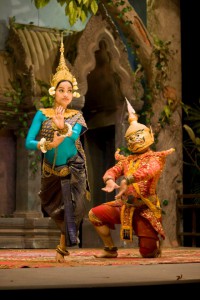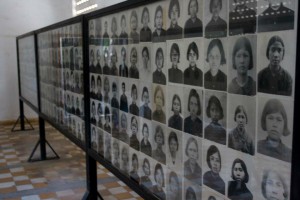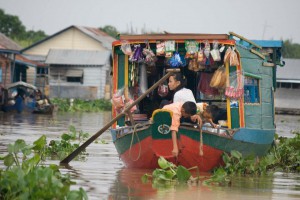The history of Cambodia has not always been pretty. Today, Cambodia is still recovering from the devastation of the Khymer Rouge period when possibly as many as 2,000,000 out of a population then of about 7 million were killed or worked to death by the Pol Pot regime. But let’s start with a happier story. We’ll make the story brief and leave out names of the many kings.
Very Early Peoples
Cambodia has been inhabited at least as early as 4200 B.C. Carbon dated ceramic pots and bones of these early cave dwellers are evidence of a people not much physically different than Cambodians of today. Ancient Chinese records describe these people.
A.D. 100—A. D. 1400 The Rise of the Angkorian Empire
The religions, language, and culture of India start to take root during these years. Chinese merchants and even envoys sent by the Chinese Wei emperor describe this Mekong region as a “barbarous but rich country”. Beginning in about 890 A.D. temples and other structures of huge carved stones begin to be built in Angkor. This is the beginning of the Angkorian Empire. This building spree continues with each leader outdoing the one before for another 400 years. Angkor Wat, the mother of all temples, was built in about 1115 A.D. The area now known collectively (by tourists) as “Angkor Wat” is actually a 64 square mile assembly of more than 50 temples, Angkor Wat being the largest. These structures are massive rock with almost every inch covered with ornate carvings of aspara dancers, soldiers, kings, gods, designs, wars, animals, celebrations, journeys, victories, and cultural mythologies. Today these structures, some lying in masses of huge piles of tumbled stones beneath the tropical forest still take your breath away. Here is the way the lonely planet 2013 edition describes it:
“The temple complex of Angkor is simply enormous and the superlatives don’t do it justice. This is the site of the world’s largest religious building, a multitude of temples and a vast, long-abandoned walled city that was arguably Southeast Asia’s first metropolis…”
These structures give testimony to the wealth and power of this Empire which exerted control over much of what is today Cambodia, Thailand, Vietnam, and Laos. This Empire was at times Hindu and at other times Buddhist. The carvings and structures reflect the history of both. This was the zenith of the Khymer people. These buildings were bigger than anything in existence in the world at that time. Many of them rival, even today the size, beauty, and scope of modern Washington D.C.’s capitol buildings. This ancient civilization document the potential and intelligence of the Khymer people.
A.D. 1400—1960 Times of Confusion, Devastation, Occupation
The Angkorian Empire ended about 1430 under attacks by the Thais. From that time until the French forced King Norodom I into signing a treaty in 1863, making it a protectorate of France, Cambodia was overrun again and again by the Vietnamese and Thais who sort of took turns controlling the country. As it turned out, the French actually preserved Cambodia from being completely wiped off the map.
The Japanese invaded and occupied Cambodia during World War II and fanned the flames of independence as the war drew to a close. In 1947 the provinces of Battambang, Siem Reap, and Sisophon which had been seized by the Thais, were returned to Cambodia.
1965—1980 The Khymer Rouge Period
During America’s Viet Nam War Khymer guerrillas launched a revolt against the Cambodian government. In 1969, President Richard Nixon authorized the secret bombing of Cambodia (with whom we were not at war). Over 250,000 Cambodians were killed in these bombings which continued until 1973. On April 17, 1975 the Khymer Rouge marched into Phnom Penh and turned the calendars back to what they called Year Zero. They imposed a ruinous vision of the past, on the country for the next four years. During that period the cities were emptied of people who were then forced to work in the country’s rice fields. Pol Pot had become enamored with the peasant life style while visiting China during Mao’s Cultural Revolution. Pol Pot returned to Cambodia and out-did Mao, determined, no matter what the cost, to make the whole country a country of peasants. The Khmer Rouge killed everyone who could speak a foreign language, who wore glasses, who was a professional (teachers, lawyers, doctors, dancers, artists, writers, business men, accountants, reporters, publishers, college-educated, professors), or whom they didn’t like. Tens of thousands fled the country—many dying in the attempt. Thailand was one of the places refugee camps were set up for those who made it out of Cambodia. It was at this time that Christopher LaPel lost both parents and his brother and sister and he escaped to Thailand.
Modern Turbulence
In 1979, the Vietnamese invaded the country, disposed of Pol Pot, and liberated the people, and set up another government. The next two years were gripped by a terrible famine as the dislocation caused by the Khymer Rouge meant that no rice had been planted or harvested. The United Nations eventually came in and stabilized the country, but it’s soldiers also fostered the child-sex industry.
Today’s Current Peace and a Window of Opportunity For The Gospel
Coalition governments have led Cambodia ever since. It has been rocky, but generally peaceful to the present time. In 2005, Cambodia joined the World Trade Organization and opened its markets to free trade. General Elections will be held in 2013 and so far things look like they will be peaceful.
Our Christian Church organization in Cambodia (Cambodian Christian Churches Organization) has won government approval and recognition. Christopher LaPel has led in that recognition by building relationships with leaders, paying for infrastructure to provide electricity to villages, and building bridges of help to the areas of Northwestern Cambodia.
Christians have a window of opportunity for the gospel at the present time. We are doing everything we can to minister to the Cambodian Khymer people who have been so decimated and devastated. They are responding in amazing numbers. Perhaps the difficulties of the recent past has opened their hearts to the hope in Christ that Hope For Cambodia brings. Only God knows how long this window will remain open, but since he opened it, we are bringing in the fresh air of the good news of Jesus.




